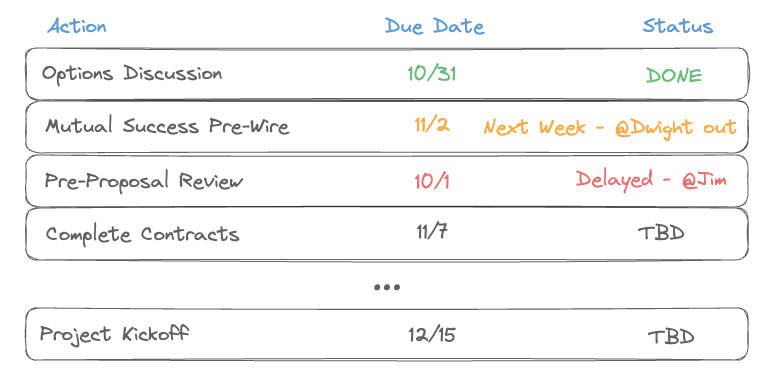The Mutual Success Plan: Your Sales Organization’s Superpower
Driving sales excellence through the magic of checklists in customer-focused dialogues.

“You don’t rise to the occasion; you fall to your level of preparation.” -Archilochus
Take a minute and clear your mind. Imagine waking up tomorrow morning, pain radiating from a dislocated hip. Glimpses of a karaoke night, flaunting dance moves a younger you could have nailed with your eyes closed, flash before you.
Fast forward a week, and you’re in surgery. You have a skilled, experienced surgical team operating. The surgery, though successful, came with a catch - they operated on the wrong hip.
Blunders like this happen more than we realize and are not relegated to just medicine. An investor ignores a key data point, costing billions. A firefighter overlooks equipment and wastes precious time. A pilot miscommunicates with air traffic control and forces an emergency landing. An account executive misplaces a contract in a sea of unread emails, resulting in a lost deal.
We need to ensure that, even in the most high-pressure situations, the critical, even basic, steps are not overlooked.
In The Checklist Manifesto, Atul Gawande points out that modern professions have become so sufficiently complex that no one human can juggle all of the things in their heads necessary to perform at a consistent level, increasing the risk of seemingly innocuous errors that can lead to catastrophic outcomes.
Our sales teams are not immune to this.
Expecting even our highest performers to follow an exact procedure across multiple sales opportunities without a structured guide is like expecting an orchestra to play a symphony perfectly without sheet music.
The highest performers in any field, sports, arts, or business, consistently demonstrate a blend of talent, skill, and meticulous preparation. In sales, these top-tier individuals and teams recognize the value of structure and methodical planning. When existing abilities to connect, persuade, and strategize are combined with the consistency of a repeatable process - their outcomes are amplified. We want minds freed up to do the hard work humans are best at - delivering value for customers, expressing creativity, and building genuine relationships.
The Mutual Success Plan: Simple Checklist, Outsized Impact
In sales organizations, creating a Mutual Success Plan is the fastest way to level up your game. Creating an MSP format to enable sales teams provides several long-term benefits to the organization and the buyer. It gives you significant bang for your buck, providing outsized returns for the effort required:
- Consistency: Ensures a uniform approach to every sale, setting a gold standard.
- Clarity: Outlines crucial steps in the sales process, minimizing oversight and increasing focus.
- Risk Reduction: Getting the plan in front of the buyer early gives time and space to adjust as necessary.
- Communication: Forces regular touchpoints with customers, fostering trust and improving the buying experience.
- Adaptability: Provides room for adjustments based on the dynamic nature of modern sales scenarios.
The Mutual Success Plan can (and should!) be simple and straightforward. It must cover all key actions taken, in partnership, between the sales team and buyer. Don’t stop at “contract signed” - there are high-touch activities needed during project kickoff and beyond in most cases. Get the train on the rails before handing over the controls.

Early on in my sales career, I found myself right in the middle of a high-visibility opportunity. Not because of any brilliance on my part; it just so happened to be the end of the quarter, and this deal would have put us over our target revenue threshold. Like holding the final vote in a 217-217 split in the U.S. House, the fortunate (or unfortunate) timing attracts more attention.
I was doing everything right. CRM was updated, and client champions and budgets were validated. We did a solid job on the pre-proposal and nailed our articulation of the customer’s problem. Unfortunately, one of the seven approvers we needed final buy-in for was in Ibiza for a month, and we ended up stuck in a holding pattern until he returned. We did the equivalent of operating on the wrong hip. Even though the sale closed successfully, the only thing anyone remembered after the fact was how the deal got pushed to the next quarter.
The Mutual Success Plan would have saved us here a few different ways. First, I would have pre-wired the discussions and had out-of-office plans top-of-mind or at least a solid Plan-B that would have kept us moving forward. Second, and most painfully, we had plenty of time to get signoff ahead of vacation had we managed the process better.
Usually, when something goes wrong in a sale, there are multiple situations where disaster would have been avoided if a slight course correction had been made early in the process. That’s what the Mutual Success Plan protects you from.
How do you transition from an internal-facing checklist to a co-created partnership approach? Great question. I’ve found the best approach is to introduce the MSP in a buyer conversation early in the process after some momentum is generated so you can demonstrate progress and preparation while having time to unroot potential blockers:
“Is there anything missing?”
“What about this seems off to you?”
“What is going to get in the way of us completing this successfully?”
“What are your major objections?”
The Mutual Success Plan isn't just a tool; it's the secret weapon of your sales organization. With its emphasis on repeatability, consistency, and adaptability, it ensures that every opportunity navigates through its critical decision points with precision and preparation. Think of it this way: just as a surgeon wouldn't make an incision without a meticulously laid-out plan, your sales team shouldn't embark on the complexities of a deal without a clear checklist.
Eager to enhance your team's consistency, boost client interactions, and sidestep those all-too-common oversights? The Mutual Success Plan is your answer. Begin by working with your team. Assess past sales, pinpoint recurring themes, and apply this knowledge to your current deals. Get something out there that isn't perfect and make it better over time. The benefit of something less effective today is better than trying to get it perfect next quarter.
If you've implemented something similar or have thoughts on refining the Mutual Success Plan further, I'd love to hear from you. The journey towards perfecting our sales process is ongoing, and collective insights can only enhance our path. After all, as we've seen, preparation isn't just the first step; it's the most crucial one.
How did you like this article? Your feedback helps me create better content.
Thanks for reading.
Subscribe for Free
Want to stay ahead of the curve? Subscribe now to receive the latest updates, actionable insights, and thought-provoking ideas around business, technology, and leadership straight to your inbox.



